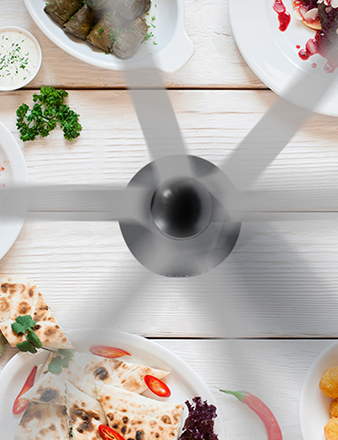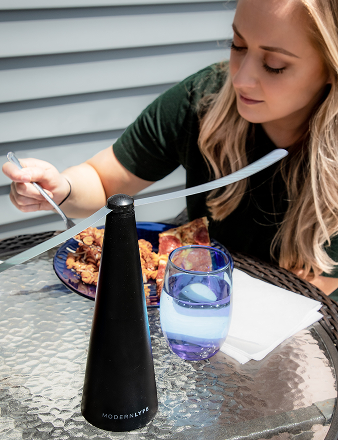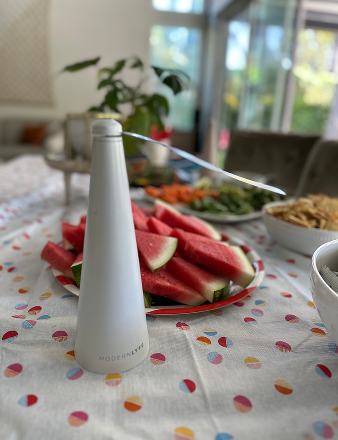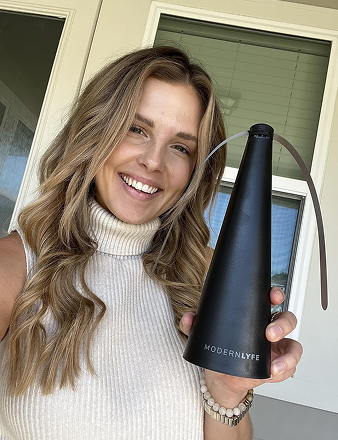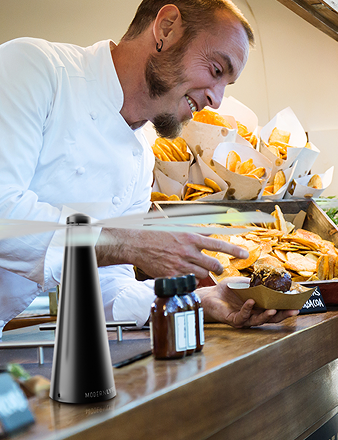A simple fan for table use does more than just cool you down. It's an effective, chemical-free tool for keeping annoying insects away. By creating a gentle airflow, it turns your dining table or outdoor space into a no-fly zone for pests like flies and mosquitoes.
Why a Table Fan is Your Secret Weapon
Let's be direct. When you think of a table fan, you think of escaping the summer heat. While they're great for that, their real, overlooked superpower is creating a bug-free environment. This isn't an accident; it's simple physics.
The steady breeze from a fan creates an air barrier that's tough for small insects to fly through. For a fly or mosquito, it's like trying to paddle a kayak against a strong river current. The fan's airflow pushes them off course, making it nearly impossible for them to land on your food or bother you.
More Than Just a Breeze
This invisible shield does more than just physically block pests. It also masks the scents that attract them. Mosquitoes, for example, track the carbon dioxide (CO2) we exhale. A fan disperses this CO2, making you effectively invisible to them.
The dual action is what makes a fan so effective: it disrupts flight paths and hides the scents that attract insects. This creates a protective bubble around your table, turning a simple appliance into a smart defense system.
Once you understand this, it's clear that not just any fan will do. Choosing the right fan for table settings means looking beyond cooling power and focusing on features that maximize this protective effect. A great example is how you can banish buzzing pests with the Modern Lyfe Fly Fan for tables, which is designed specifically for this purpose.
Choosing for Comfort and Protection
The key is finding the right balance. You need enough airflow to stop bugs, but not so much that it blows napkins off the table or chills your food. This is where modern table fans excel, offering features suited for this dual role.
Here’s what to look for when choosing a fan for insect control:
- Adjustable Speed Settings: Lets you find a breeze strong enough to deter bugs but gentle enough not to be a nuisance.
- Quiet Operation: Look for a fan with a silent motor. The goal is to protect your space without adding a distracting hum.
- Portability and Power Source: Battery-operated or USB-powered fans offer the flexibility to place them exactly where needed.
To make the choice easier, here's a quick guide.
Quick Guide to Selecting Your Fan
| Factor | Why It Matters | What to Look For |
|---|---|---|
| Airflow Strength | Too weak won't stop bugs. Too strong blows things around. | Multiple or variable speed settings to find the sweet spot. |
| Noise Level | A loud fan is as annoying as the pests it's repelling. | Models advertised as "whisper-quiet" or with low decibel (dB) ratings. |
| Power Source | Determines where and how you can use the fan. | Battery-operated or USB-rechargeable models for portability. |
| Blade Design | Safety is critical, especially around food and kids. | Soft, flexible blades that stop on contact are ideal. |
Choosing a fan with these features ensures you get a device that keeps you comfortable and keeps pests away. This elevates a simple gadget into a year-round essential for a more pleasant and hygienic space.
How Airflow Creates an Invisible Pest Shield
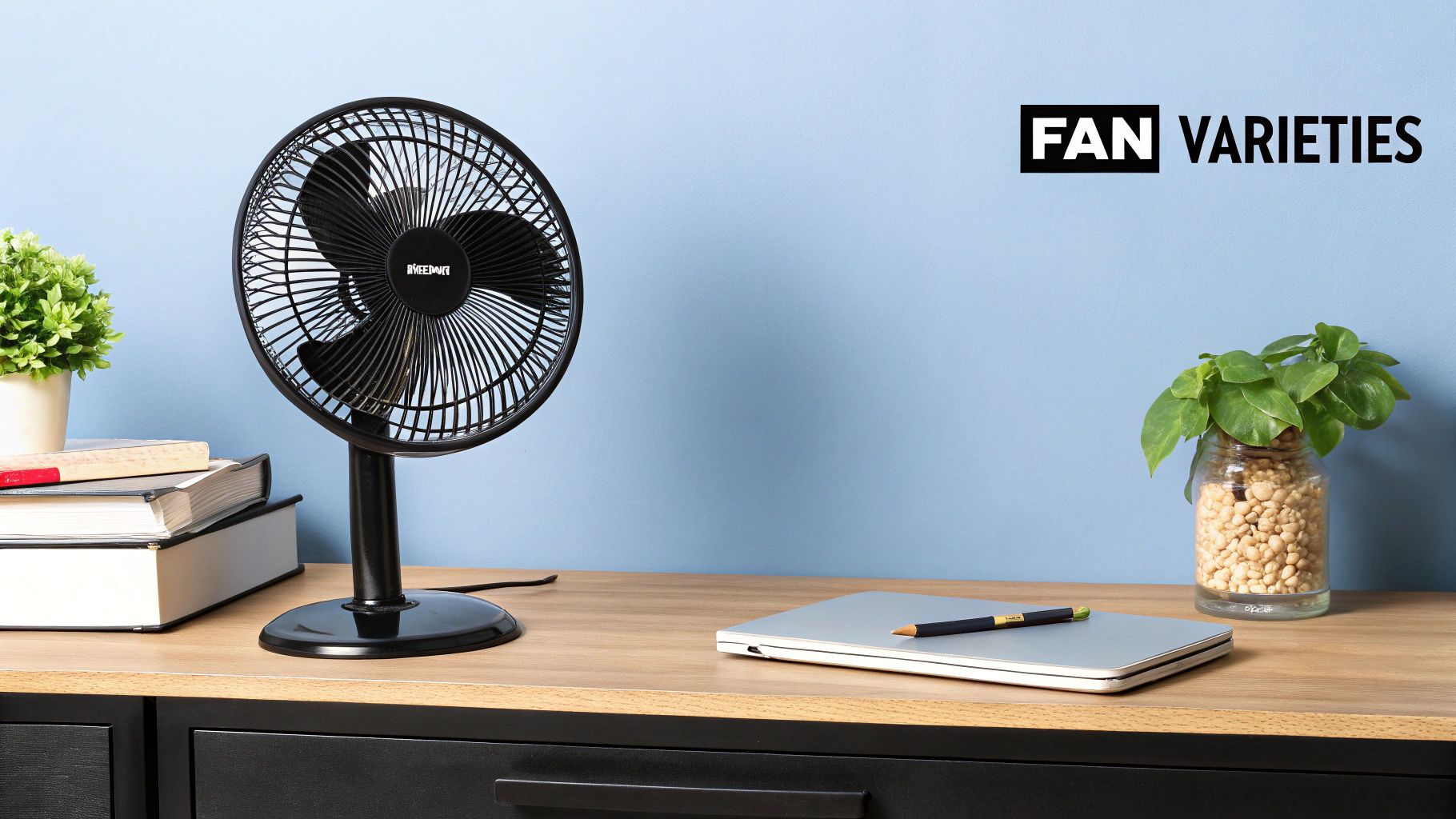
It’s hard to believe a simple table fan can be so effective against pests. The secret isn't chemicals or zappers; it's basic physics and insect biology. A fan creates a micro-environment where pests can't function.
The constant breeze from a fan for table use creates a turbulent, windy zone. For small insects like flies, gnats, and mosquitoes, this is a serious navigational hazard. These bugs are fragile fliers and rely on still air to get around.
Imagine trying to steer a paper boat across a river. The current whisks it away. That’s what a fan's airflow does to a fly trying to land on your plate. It's an invisible wall they can't push through.
The Power of Disruption
This invisible shield works because it disrupts insects on multiple levels. It’s not about force, but about making the environment inhospitable.
- Interrupting Flight Paths: The moving air physically blocks insects from reaching your food. They can't maintain a steady flight path.
- Creating a No-Fly Zone: A well-placed fan for table settings establishes a protective bubble over an area. Insects are hardwired to avoid conditions they can't fly in.
- Consistency is Key: For larger areas, an oscillating fan is a great choice. It sweeps the protective air back and forth, clearing a much wider space.
It’s a perfect example of outsmarting pests with science. If you want more ways to protect your meals, our guide on how to keep flies away from food offers other chemical-free strategies.
Masking the Scent Trail
There's another critical benefit to using a fan: it makes you disappear. Pests like mosquitoes hunt you by tracking the carbon dioxide (CO2) you exhale. This CO2 trail is a bright beacon that says "dinner is here!"
A fan’s breeze scatters that CO2 plume, diluting the signal until it’s too faint for a mosquito to follow.
Think of it like trying to follow a thin trail of smoke in a windy field. The wind breaks it apart, making the source impossible to find. That's how a fan makes you "invisible" to scent-hunting pests.
This two-pronged attack—a physical barrier and a chemical cloak—is what makes a simple fan so effective. It proves that sometimes the simplest solutions are the best.
This isn’t just a niche trick. The global market for table fans was around USD 4.1 billion in 2023 and is projected to reach USD 6.9 billion by 2032. You can learn more about the table fan market findings on dataintelo.com to see the full data. This trend highlights a shift toward practical, simple, and energy-efficient solutions for comfort and pest control.
Decoding Modern Table Fan Features
We've covered how a fan creates a bug-free bubble. Now, let's talk about the what—the specific features that make a fan for table use a true powerhouse for pest control and comfort. For keeping bugs away, some features are more important than others.
Choosing the right fan isn't just about price. It’s about matching its power, sound, and design to your space. A fan that’s perfect for a large patio will feel like a hurricane in a home office.
The Heart Of The Fan: Power And Airflow
If you only look at one spec, make it Cubic Feet per Minute (CFM). This number tells you how much air a fan can move. A higher CFM means a stronger breeze and a larger bug-free zone.
But more power isn't always better. For a small dining table, a fan on full blast will just send napkins flying. You want a gentle, steady breeze, not a wind tunnel. That's why adjustable speed settings are essential—they let you dial in the perfect balance.
It's no surprise that practical cooling solutions are so popular. The table fan market was valued at about USD 2.6 billion in 2022 and is expected to grow as people seek more energy-efficient models.
Oscillation: Spreading The Protection
Oscillation is the side-to-side sweeping motion. While a stationary fan creates a focused column of air, an oscillating fan spreads that airflow over a much larger area.
This feature is a game-changer for protecting larger spaces:
- Family Dining Tables: One oscillating fan can cover the whole table.
- Buffet Lines: Set one at the end of a buffet to keep the entire spread clear of flies.
- Outdoor Patios: The sweeping motion creates a larger "no-fly zone" for you and your guests.
For a personal desk, oscillation might be overkill. But for any shared space, it’s a must-have for maximum coverage.
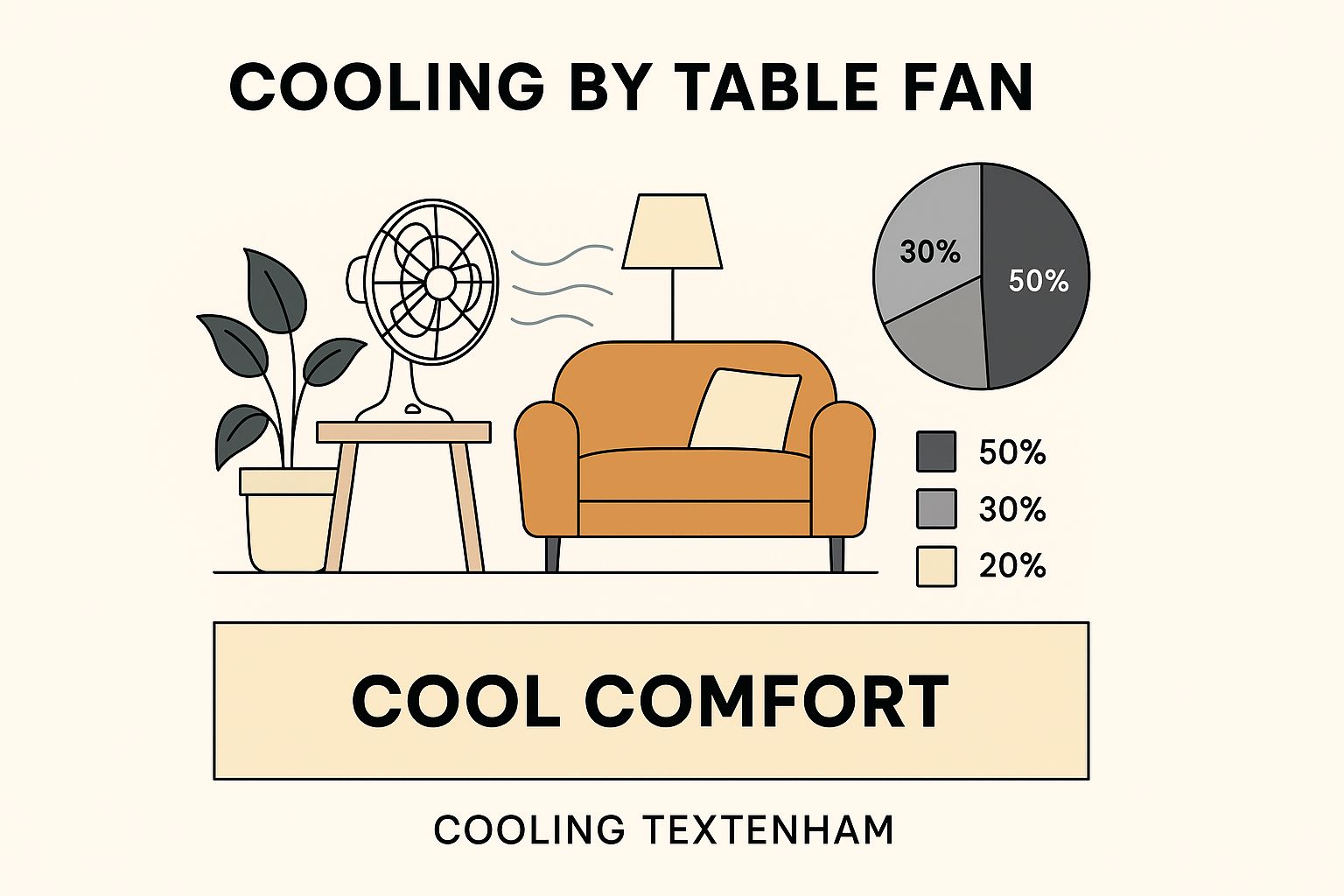
As you can see, the right fan doesn't just work well—it blends in, adding function without disrupting your style.
Noise Level: The Sound Of Silence
A fan's noise level is measured in decibels (dB). A loud fan can be more annoying than the bugs it's repelling. For a home office or a quiet dinner, a low decibel rating is non-negotiable.
Many of the best fly repellent fan models are built for quiet operation. Look for phrases like "whisper-quiet" or fans with DC motors, which are much quieter than older AC motors.
When comparing fans, remember that a 10 dB difference is huge—it sounds twice as loud to our ears. A fan at 30 dB is a whisper, while one at 50 dB sounds like a normal conversation.
Power Source: Freedom And Flexibility
Your fan's power source determines where and how you can use it. Each option has clear pros and cons.
- Corded (AC Power): Classic plug-in fans. They deliver consistent power and are perfect for permanent spots like a desk.
- Battery-Operated: All about portability. Place these anywhere—a picnic blanket, a patio table, or a campsite. No cords, no limits.
- USB-Powered: These versatile fans can plug into a laptop, power bank, or USB wall adapter. A great low-energy choice for personal workspaces.
Comparing Modern Table Fan Features
This direct comparison will help you pinpoint the best fan for your needs, whether it's for your desk, dining table, or patio.
| Feature | Budget Option | Mid-Range Option | Premium Option |
|---|---|---|---|
| Power (CFM) | Lower CFM, suitable for personal space. | Moderate CFM with multiple speed settings. | High CFM with variable speed control for precise airflow. |
| Noise Level | Often louder, especially on high. | Quieter operation, often below 45 dB. | Whisper-quiet, using a DC motor (under 35 dB). |
| Oscillation | Typically stationary. | Basic oscillation (e.g., 90-degree sweep). | Wide-angle oscillation, sometimes with vertical tilt. |
| Power Source | Usually single-source (corded or basic battery). | Often includes USB and battery options. | Rechargeable, long-lasting lithium-ion battery and USB-C. |
By understanding these core features, you can pick a fan for table use that does exactly what you need, giving you a bug-free and comfortable space.
Strategic Placement for Maximum Airflow
You have a great fan. Now you need to place it correctly. Where you put your fan for table use can be the difference between a relaxing, pest-free meal and swatting away uninvited guests.
Think of the airflow as a security guard. If you post them in the wrong spot, they can't do their job. The goal is to create a consistent, tactical current of air that protects the entire area you need.
Creating an Impenetrable Air Barrier
For the best results, create a low, horizontal air barrier that skims over your table's surface. Most flying insects, like flies and mosquitoes, fly low when approaching food. By positioning your fan to blow across the table, you build an invisible fence they can’t cross.
You want a gentle but firm breeze—noticeable, but not strong enough to blow napkins or chill your food. This low-level airflow disrupts their flight path before they can land.
Common Placement Mistakes to Avoid
People often make a few key mistakes that reduce a fan's effectiveness. Luckily, they're all easy to fix.
- Placing It Too High: Pointing a fan down from a tall counter is fine for room cooling, but bad for bug control. The air spreads out too much and loses the focused stream needed to stop insects.
- Positioning It Too Close: Placing the fan right next to you creates an annoying, concentrated jet of air that's uncomfortable and blows things around.
- Using the Wrong Speed: Cranking it to high is usually overkill. You only need enough force to deter a lightweight fly, not create a wind tunnel. A medium, steady speed is almost always more effective.
The sweet spot for a fan for table use is one to three feet away, aimed to create a gentle, cross-table breeze. This provides enough distance for the airflow to spread out without being overpowering.
Avoiding these common errors is key. With the right placement, the fan does the work for you.
Mastering Angles and Oscillation
The angle of the fan head is as critical as its location. For a typical dining table, point the fan so the air runs parallel to the tabletop, creating that ideal horizontal barrier. If your fan has an adjustable tilt, experiment to find the perfect angle for maximum coverage.
For a larger space, like a long buffet table or a big outdoor seating area, oscillation is your secret weapon.
An oscillating fan sweeps the protective air back and forth, effectively doubling or tripling your "no-fly zone." It creates a moving wall of air that keeps a much wider area clear. It’s a must-have for parties or family gatherings. When choosing a fan for table use, consider if you'll need to cover more than just your personal space.
Keeping Your Fan Running Like New
Your table fan is an investment in comfort and pest-free meals. Like any tool, it needs upkeep to perform at its best. Over time, dust and grime can build up on the blades and grille, turning your silent breeze machine into a noisy, ineffective mess.
The difference between a powerful fan and one that just makes noise is often just a few minutes of care each month. It's about performance and making your investment last.
A Quick and Easy Cleaning Routine
Getting your fan back to top condition is simple. First and most importantly: Always unplug the fan or disconnect the battery. Safety first.
- 1. Remove the Grille: Most table fans have a front cage held on by clips or small screws. Gently remove it to access the blades.
- 2. Wipe the Blades: Use a damp cloth with a bit of mild soap to wipe down each blade and remove dust. A soft brush can help with stubborn spots.
- 3. Wash the Grille: Wash the grille in warm, soapy water. Use a brush to clean out tight corners.
- 4. Dry and Reassemble: This is a crucial step. Ensure every part is completely dry before reassembling. A damp blade is a magnet for new dust.
Following this routine once a month will keep your fan quiet and powerful enough to maintain a bug-free zone.
Why Consistent Care Matters
A clean fan is an effective fan. When blades are weighed down with dust, the motor strains to spin them, causing noise and wear.
Clean blades slice through the air effortlessly, creating the strong, steady breeze you need. This principle of efficient air movement is why fans are a household staple.
The fan market itself is a testament to their reliability. In 2021, the global fan market, including the essential fan for table, was valued at USD 11.1 billion. It's projected to grow to nearly USD 16.8 billion by 2031, proving our reliance on these simple machines. You can see more details in this market analysis from Allied Market Research.
A dirty fan struggles to do its job. A clean fan operates at peak efficiency, delivering the powerful, quiet airflow that keeps your space comfortable and bug-free.
A few minutes of routine care ensures your fan remains a silent, dependable guardian of your peace. It’s a small effort that pays off in performance and longevity.
Common Questions About Table Fans
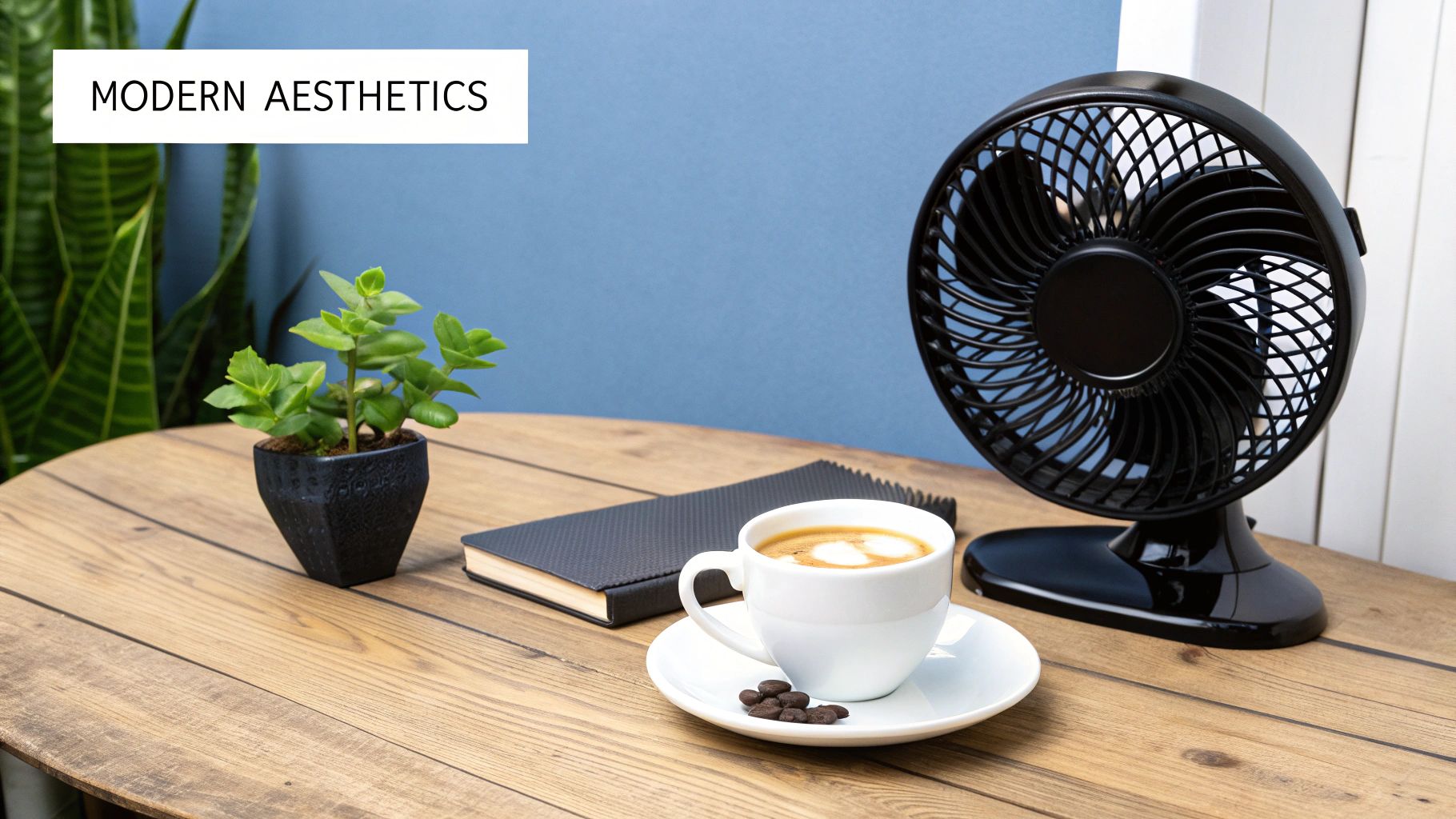
Even after learning how these fans work, you might still have a few questions. Let’s tackle the most common ones so you can get the best results.
How Powerful Does a Fan Need to Be to Keep Flies Away?
You don't need a hurricane. A fan that produces a steady, gentle breeze is usually enough to deter flies and other pests. The key is having adjustable speed settings.
Start on the lowest setting and dial it up. The sweet spot is just enough power to bother bugs without blowing napkins around. You're just disrupting their flight, not redecorating your table.
For most standard dining or picnic tables, a fan that moves around 200-300 CFM (Cubic Feet per Minute) on a medium setting is a great benchmark. This creates an effective but not overwhelming no-fly zone.
Will a Table Fan Use a Lot of Electricity?
Not at all. Modern table fans are highly efficient, using a fraction of the power of an air conditioner. A typical fan for table use pulls only about 25 to 75 watts.
Even if you run it all afternoon, you’ll barely notice it on your electricity bill. For maximum efficiency, look for a model with a DC motor. They're known for being incredibly quiet and even more economical.
Are Bladeless Fans As Effective for Repelling Insects?
Yes, and in some ways, they are even better. While a traditional fan creates a turbulent airflow, a bladeless fan produces a smooth, uninterrupted stream of air.
That consistent column of air is ideal for creating an invisible wall that insects can't penetrate. They tend to cost more, but the benefits are compelling:
- Enhanced Safety: No spinning blades makes them safer around kids and pets.
- Easy Cleaning: Wiping a smooth surface is easier than cleaning individual blades and grilles.
- Consistent Airflow: The steady stream of air creates a more reliable barrier against pests.
Can I Use a Table Fan Outdoors on a Patio?
Absolutely. This is one of the best uses for a fan for table settings. When using electricity outdoors, safety is paramount. If you use a corded fan, ensure it is rated for outdoor or "damp" conditions.
It's also crucial to plug it into a GFCI (Ground Fault Circuit Interrupter) outlet, which cuts power if it detects moisture. For total flexibility and peace of mind, a battery-powered or rechargeable fan is an even better option. It eliminates cords and can be placed exactly where needed.
Ready to reclaim your meals from pesky flies? The fly fan from MODERN LYFE is designed to provide quiet, effective, and stylish protection for any table. Click here to get your Modern Lyfe fan today!

